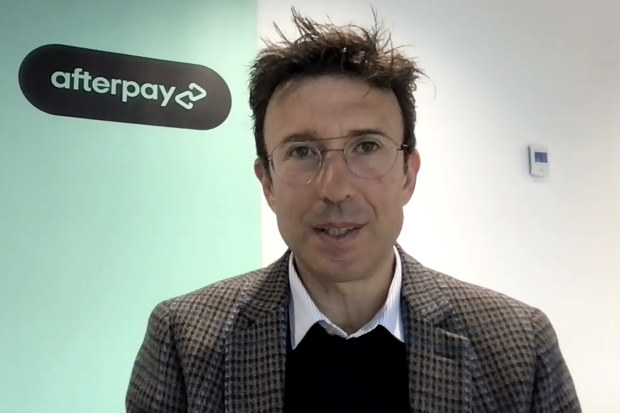The buy now, pay later industry’s advantage is that their real clients are merchants, not shoppers.
The Lex ColumnKlarna and the rest of the buy now, pay later brigade offer shoppers instant gratification. Investors must be a little more patient.
A pair of Australian rivals, Afterpay and Zip, lost nearly $US600 million ($820 million) on the bottom line last year. Sweden’s Klarna, also reporting on Wednesday, made an interim net loss of $US162m at the halfway stage. Booming revenues were virtually all swallowed up in costs. Net credit losses were roughly the same as interest income.
On to an eventual winner. Afterpay CEO Anthony Eisen. AFR
No matter. Top line growth still informs the sector’s sky-high valuations: $US45.6 billion for privately owned Klarna and $39.3 billion , or 42.5 times revenues, for Afterpay, which is being acquired by Square.
The case against BNPLs rests on regulation. Watchdogs across the globe are scrutinising the industry, concerned that – like payday loans and other ready cash products – it will lead shoppers to spend more than they can afford and amass debt.
The industry’s advantage is that their real clients are merchants, not shoppers. These have swooped on BNPL providers in droves. Klarna boasts a quarter of a million retail partners globally; Afterpay more than 100,000.
For merchants, the proposition is a boost to the top line, improved cash flow and removal of credit risk.
Klarna claims shoppers spend an average of up to 68 per cent more with its BNPL product. It then plays a factoring-style role, paying the merchant upfront while it collects monthly instalments from the end customer.
Merchants are more than willing to give a cut in return. Afterpay reported a merchant margin – income as a percentage of underlying sales – of 3.9 per cent last year.
Use has expanded from young e-commerce site buyers spreading out the cost of $US20 jeans over a few months. John Lewis, middle England’s favourite department store, offers interest free credit on electrical goods up to £25,000 ($47,000).
Watchdogs remain a threat. But Klarna and its ilk have succeeded in stitching themselves into e-commerce and retail ecosystems, supplementing their services with marketing and other merchant tools – much like China’s Alibaba platform.
Credit card purveyors such as Visa and Mastercard will be watching their progress just as nervously as regulators.
Financial Times
- Forums
- ASX - By Stock
- AFR Opinion - Afterpay and friends a case of invest now, profit later
The buy now, pay later industry’s advantage is that their real...
-
- There are more pages in this discussion • 1 more message in this thread...
You’re viewing a single post only. To view the entire thread just sign in or Join Now (FREE)
Featured News
Add ZIP (ASX) to my watchlist
 (20min delay) (20min delay)
|
|||||
|
Last
$1.31 |
Change
-0.035(2.61%) |
Mkt cap ! $1.465B | |||
| Open | High | Low | Value | Volume |
| $1.34 | $1.35 | $1.30 | $12.38M | 9.417M |
Buyers (Bids)
| No. | Vol. | Price($) |
|---|---|---|
| 1 | 4999 | $1.31 |
Sellers (Offers)
| Price($) | Vol. | No. |
|---|---|---|
| $1.31 | 14549 | 5 |
View Market Depth
| No. | Vol. | Price($) |
|---|---|---|
| 2 | 1688 | 1.310 |
| 4 | 38399 | 1.305 |
| 11 | 138536 | 1.300 |
| 3 | 70540 | 1.295 |
| 5 | 104913 | 1.290 |
| Price($) | Vol. | No. |
|---|---|---|
| 1.250 | 3139 | 2 |
| 1.280 | 1537 | 1 |
| 1.305 | 801 | 2 |
| 1.310 | 21374 | 2 |
| 1.315 | 23700 | 3 |
| Last trade - 16.10pm 08/05/2024 (20 minute delay) ? |

|
|||||
|
Last
$1.31 |
Change
-0.035 ( 3.24 %) |
||||
| Open | High | Low | Volume | ||
| $1.34 | $1.35 | $1.30 | 2199410 | ||
| Last updated 15.59pm 08/05/2024 ? | |||||
Featured News
| ZIP (ASX) Chart |
The Watchlist
LU7
LITHIUM UNIVERSE LIMITED
Alex Hanly, CEO
Alex Hanly
CEO
SPONSORED BY The Market Online





